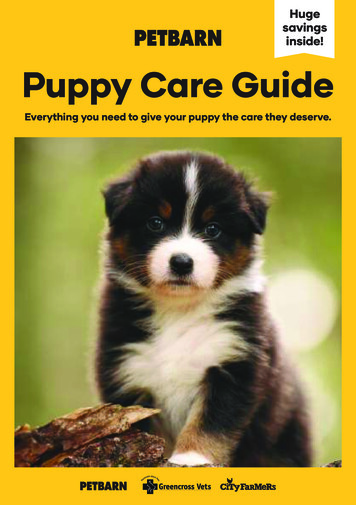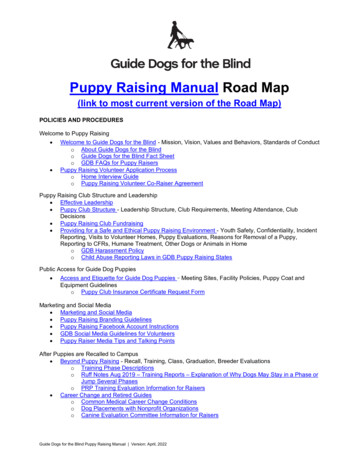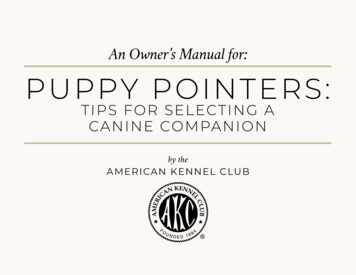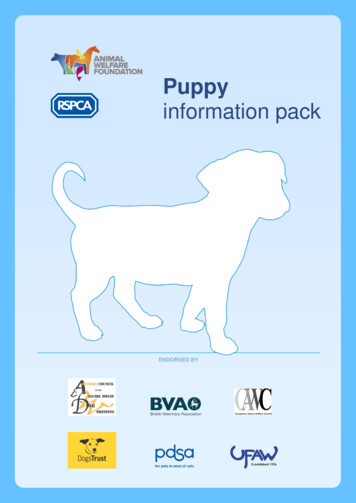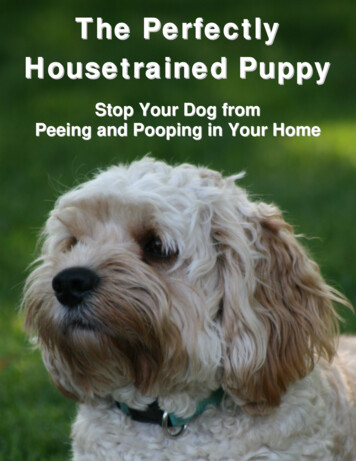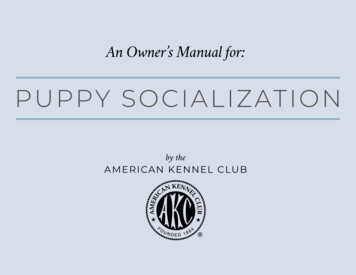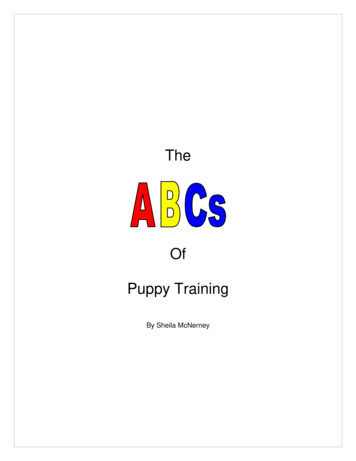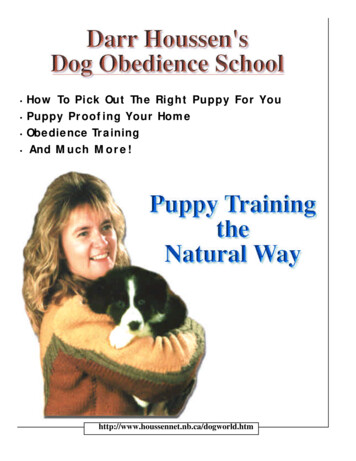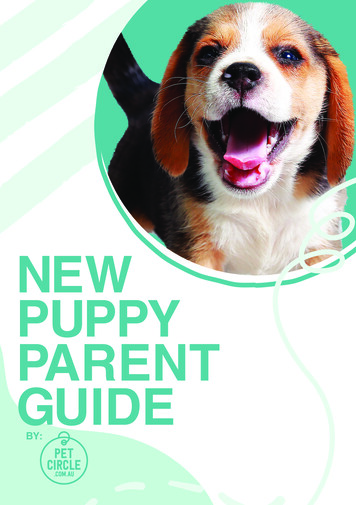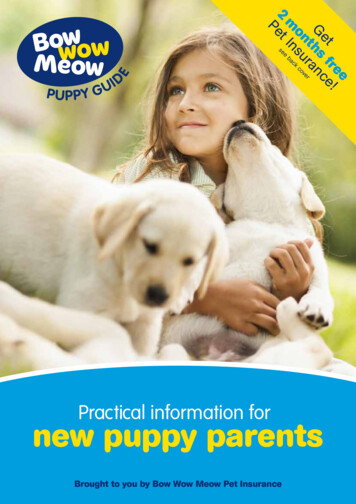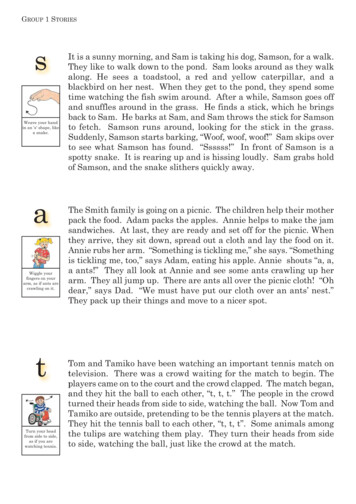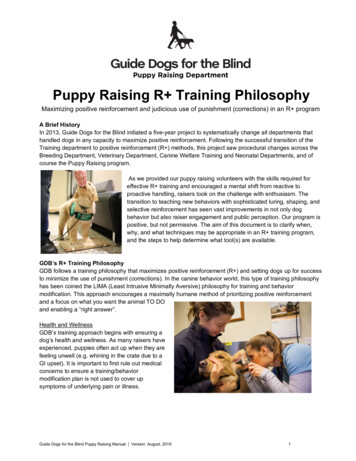
Transcription
Puppy Raising DepartmentPuppy Raising R Training PhilosophyMaximizing positive reinforcement and judicious use of punishment (corrections) in an R programA Brief HistoryIn 2013, Guide Dogs for the Blind initiated a five-year project to systematically change all departments thathandled dogs in any capacity to maximize positive reinforcement. Following the successful transition of theTraining department to positive reinforcement (R ) methods, this project saw procedural changes across theBreeding Department, Veterinary Department, Canine Welfare Training and Neonatal Departments, and ofcourse the Puppy Raising program.As we provided our puppy raising volunteers with the skills required foreffective R training and encouraged a mental shift from reactive toproactive handling, raisers took on the challenge with enthusiasm. Thetransition to teaching new behaviors with sophisticated luring, shaping, andselective reinforcement has seen vast improvements in not only dogbehavior but also raiser engagement and public perception. Our program ispositive, but not permissive. The aim of this document is to clarify when,why, and what techniques may be appropriate in an R training program,and the steps to help determine what tool(s) are available.GDB’s R Training PhilosophyGDB follows a training philosophy that maximizes positive reinforcement (R ) and setting dogs up for successto minimize the use of punishment (corrections). In the canine behavior world, this type of training philosophyhas been coined the LIMA (Least Intrusive Minimally Aversive) philosophy for training and behaviormodification. This approach encourages a maximally humane method of prioritizing positive reinforcementand a focus on what you want the animal TO DOand enabling a “right answer”.Health and WellnessGDB’s training approach begins with ensuring adog’s health and wellness. As many raisers haveexperienced, puppies often act up when they arefeeling unwell (e.g. whining in the crate due to aGI upset). It is important to first rule out medicalconcerns to ensure a training/behaviormodification plan is not used to cover upsymptoms of underlying pain or illness.Guide Dogs for the Blind Puppy Raising Manual Version: August, 20191
ManagementThis entails setting puppies up for success, and can take many different forms.People commonly think of management in the house: crates, tie downs, andbaby gates to prevent the puppy from accessing inappropriate items before s/hehas learned how to behave around them. The following are also examples ofappropriate management choices: Working on puppy handling with a calm, sleepy pup rather than one thatis eager for play time. Using a Gentle Leader head collar on the puppy if the raiser anticipatesa high distraction environment. Choosing not to take the puppy on an inappropriately challenging outing.Food Rewards for Desirable Behavior (R )Rewarding with food is what generally comes to mind when we think of R training.When we are training a new behavior or trying to change an existing behavior, food isgenerally the most practical reward for the dogs in our program. The Trainingdepartment also uses food rewards when teaching formal guidework skills. It isimportant that puppies learn that their behavior can earn food rewards.Note: Throughout puppy raising, praise/petting should also be used generously toreward good choices, so that puppies enter formal training enjoying praise and pettingin addition to food rewards.These tools are all that are necessary when teaching puppies new commands and skills, in the absence ofunwanted behaviors. When training new behaviors, managing the training environment is important todevelop confident puppies that are eager to try to earn food rewards for offering correct choices.What About the Real World?Of course, we acknowledge that training sessions don’t always go as planned. If the puppy isn’t learning skillsas quickly as expected, the raiser should go back to the first three tools (ensuring the pup is physicallycomfortable; management to prevent undesirable behavior and rewards for desirable behavior).Considerations When the Puppy Isn’t Progressing A higher rate of reinforcement or better reward timing may help the puppy understand what is beingrequested. Puppies are individuals and learn at different rates: a puppy may pick up one skill quickly but maystruggle with other behaviors. As long as puppies aren’t practicing inappropriate behaviors, it often helps to lower expectations andmake the exercise easier for the puppy.Guide Dogs for the Blind Puppy Raising Manual Version: August, 20192
A puppy that fails to perform a requested cue is either insufficiently motivated ordoes not know the cue as well as the raiser thinks! Corrections are not aneffective way to teach new skills and should not be used while teaching a newbehavior.Dealing With Inappropriate BehaviorsSometimes, even with the best foresight, puppies display inappropriatebehaviors. “Positive” training is not “permissive” training. Inappropriate behaviorsstill crop up, even with very creative management. This is especially commonwhen it comes to house behavior and behavior in high distraction situations. Infact, as the puppy matures, the occasional slip-up is not unusual as the pup isgiven more freedom and responsibility to make correct choices on its own.Reward Alternative BehaviorThe first tool when dealing with inappropriate behaviors is toproactively reward an alternative behavior; teach the puppy anappropriate behavior that is incompatible with the behavior theynaturally want to exhibit. For example, if a puppy jumps up onvisitors, the raiser can teach the pup to lie calmly on a dog bedinstead. Lying on a bed away from the visitors is physicallyincompatible with jumping on visitors. These alternative skillsshould first be taught in a non-distracting environment beforebeing introduced to more and more difficult situations (e.g.introducing Go to Bed when there are no distractions, then doingset ups with a training partner practicing entrances and exits,eventually working up to strangers knocking on the door.)Removing Reinforcement (P-)What if the puppy does exhibit an unwanted behavior? We start by removingreinforcement (i.e. removing what the puppy wanted). For example, puppiesoften vocalize to seek attention from the raiser. They have learned that thesebehaviors are rewarded by attention. Actively removing attention (i.e. turningaway or even walking out of the room, if it is safe to do so) when the puppyvocalizes, teaches the puppy that this behavior results in the removal of thething the puppy wanted (attention), and decreases the likelihood the puppywill choose to vocalize the next time it wants attention. And if the raiser hasdone a good job of teaching an alternative behavior (e.g. sitting quietly), it islikely the puppy will choose to offer that behavior instead.Correction (P )Lastly, sometimes circumstances require immediately stopping an undesirable behavior, whether because ofthe puppy or raiser’s safety, or the undesirable behavior itself is rewarding (e.g. chewing on inappropriateitems, or counter-surfing). Other times, puppies become frustrated when something that was previouslyrewarded now results in the removal of rewards, causing unwanted behavior to occur with more and moreintensity and vigor. These situations require correction to stop the behavior to prevent further escalation andto help the puppy choose a more appropriate response. The type and intensity of correction may vary basedon the situation and the puppy’s prior training history. Raisers should receive instruction from their leader/CFRon how to determine and implement the lowest level of effective correction required in a given situation. Thegoal of a correction is to stop the unwanted behavior so that the raiser can quickly go back to rewarding theGuide Dogs for the Blind Puppy Raising Manual Version: August, 20193
puppy for making an appropriate choice instead. It is critical to always maintain an emotionally neutraldemeanor if a correction is required.If raisers find it necessary to apply corrections repeatedly to stop a behavior, this indicates a need to changethe environment and/or review handling techniques. If a raiser is giving frequent corrections, they should seekhelp from a leader/CFR.In no instance is it ever acceptable to correct a puppy by verballyintimidating, hitting, or kicking the puppy.(For house behavior issues that occur when the puppy is home alone,leaders can reach out to their CFR for special protocols.)SummaryGDB’s training philosophy maximizes positive reinforcement andencourages a proactive training approach. R training emphasizessetting puppies up for success by teaching appropriate behaviors andmanaging challenging situations to give the puppy the best chance tomake correct choices (and be rewarded for doing so!). There are also anumber of tools in our toolbox for situations where puppies do performundesirable behaviors in order to teach them how to behave instead.Raisers are encouraged to speak with their leader (who may consultwith the CFR) if the puppy is not responding appropriately orprogressing as expected.Guide Dogs for the Blind Puppy Raising Manual Version: August, 20194
A visual representation of the GDB Puppy Raising Roadmap of Reinforcement, inspired by Dr. Susan G. Friedman’s Hierarchy ofBehavior Change Road Map (http://www.behaviorworks.org/files/downloadable art/Hierarchy%20Road%20Map%20curve.png)Guide Dogs for the Blind Puppy Raising Manual Version: August, 20195
Guide Dogs for the Blind Puppy Raising Manual Version: August, 2019 1 . Puppy Raising R Training Philosophy . Maximizing positive reinforcement and judicious use of punishment (corrections) in an R program. A Brief History . In 2013, Guide Dogs for the Blind initiated a five-year project to systematically change all departments that
